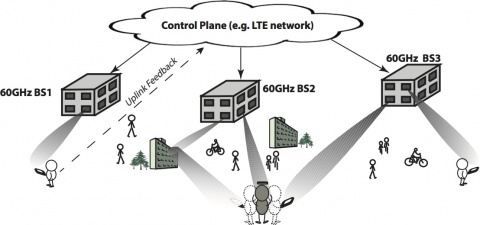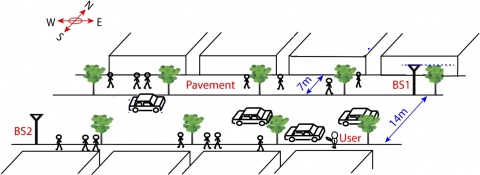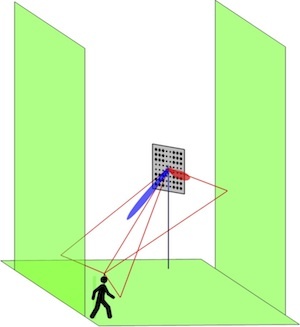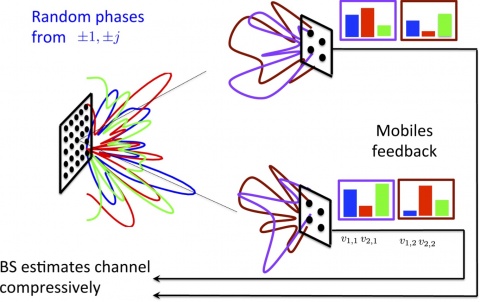Exponential growth in mobile data traffic on one hand and the recent progresses in low cost silicon RFICs on the other hand, have raised mm-wave band communication as a strong candidate for future cellular networks. Going to higher carrier frequencies will potentially bring us orders of magnitude increase in bandwidth. Moreover, small wavelengths (e.g., 5mm at 60 GHz) allow fitting electronically large (1000-element) antenna arrays in small form factors. As a result, highly directive links are easily realizable. This arises the idea of small cell architecture through which aggressive spatial reuses are achievable.
Specific characteristic of wave propagation in mm-wave band that arises the blockage problem as well as highly directive antennas make the PHY and MAC layer aspects of the mm-wave small cells to be different from conventional microwave cellular networks and need to be reinvestigated.
Figure 1. A typical structure for mm-wave outdoor cellular networks
In this project, we (collaborating with Prof. Zheng’s goup) conducted some preliminary experiments in UCSB campus as well as downtown Santa Barbara with off the shelf 60GHz chips that are originally designed for indoor applications, to show the feasibility of maintaining robust links over hundreds of meters ranges in urban canyon pico-cell networks.
Figure 2. A typical urban environment
Moreover, we have investigated the characteristics of the inter-cell and intra-cell interference in pico-cell networks. Our geometric analysis that is tailored to urban canyon environments shows that in small cell structure of our interest neither the noise nor the interference are the bottlenecks and with minimal coordination among neighboring base stations, the maximum capacity, limited by the hardware constraints, is achievable. A rough estimation of the achievable capacity gain over LTE networks demonstrates that the promised 1000X capacity is achievable in a dense mm-wave picocell network.
Channel estimation is one of the essential parts in establishing directive mm-wave links. In order to beamform toward the desired user as well as to overcome the blockage problem, an inventory of the available paths from base stations to each user is needed. Figure (3) shows four possible paths to a single user in urban canyon environment.
Figure 3. Multiple paths in urban canyon environments
Given the sparse nature of the mm-wave channel, we have proposed a compressive estimation approach, which apply NOMP (Newtonized Orthogonal Matching Pursuit) algorithm to the random projections of the channel on a smaller subspace. Figure (4) shows the architecture of our proposed channel estimation protocol.
Figure 4. Architecture of compressive channel estimation
Students
Zhinus Marzi
Faculty
Upamanyu Madhow




